Lennox EBSTPM-2, EBSTNM-2 User Manual
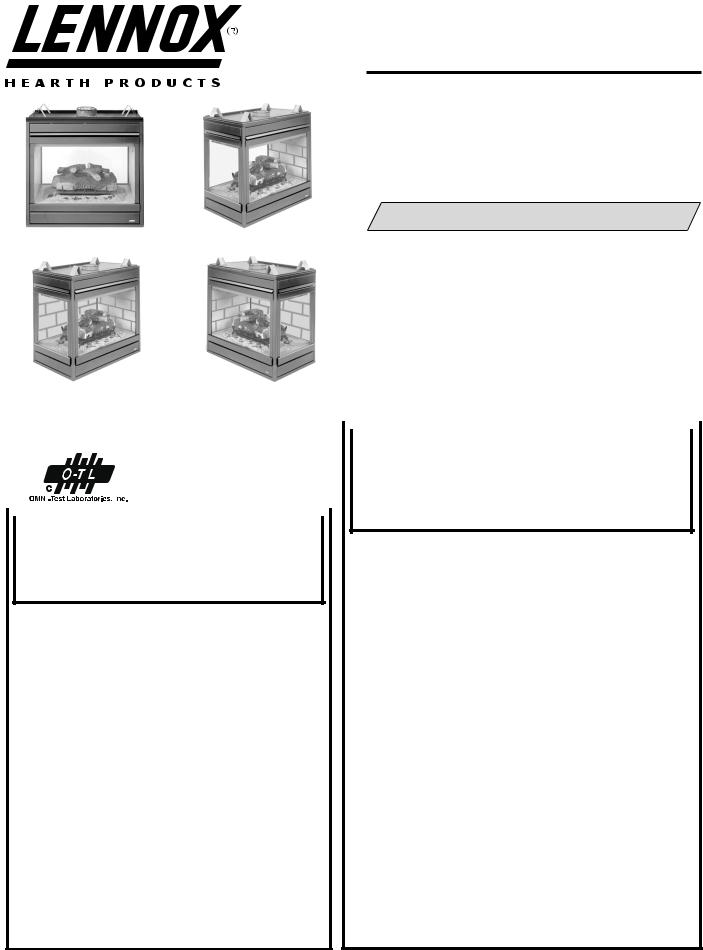
HOMEOWNER'S CARE AND
OPERATION INSTRUCTIONS
|
|
|
|
|
|
|
|
|
|
B-VENT MULTI-OPEN |
||||
|
|
|
|
|
|
|
|
|
|
|
ELITE® SERIES |
|
|
|
|
|
|
|
|
|
|
|
|
|
B-VENTED GAS APPLIANCES |
|
|
|
|
|
|
|
|
|
|
|
|
|
|
P/N 875,012M REV. D 05/2004 |
|
|
|
|
|
|
|
|
|
|
|
|
|
|
MODELS |
|
|
|
|
|
EBST (See-through) |
EBPF (Peninsula) |
|
|
|
|
|
|
|
|
||||
|
|
|
|
|
|
|
|
|
|
Millivolt Models |
Electronic Models |
|||
|
|
|
|
|
|
|
|
|
|
EBSTNM-2 |
EBCRNM-2 |
EBSTNE-2 |
EBCRNE-2 |
|
|
|
|
|
|
|
|
|
|
|
EBSTPM-2 |
EBCRPM-2 |
EBSTPE-2 |
EBCRPE-2 |
|
|
|
|
|
|
|
|
|
|
|
EBPFNM-2 |
EBCLNM-2 |
EBPFNE-2 |
EBCLNE-2 |
|
|
|
|
|
|
|
|
|
|
|
EBPFPM-2 |
EBCLPM-2 |
EBPFPE-2 EBCLPE-2 |
||
|
|
|
|
|
|
|
|
|
|
EBBAYNM |
EBBAYNP |
EBBAYNE |
|
|
|
EBCL (Corner-Left) |
EBCR (Corner-Right) |
|
|
|
|
|
|
|
|
||||
|
|
RETAIN THESE INSTRUCTIONS |
|
|
|
|
|
|
|
|
||||
|
|
|
|
|
|
|
|
|
||||||
|
|
FOR FUTURE REFERENCE |
|
|
AVERTISSEMENT: ASSUREZ-VOUS DE BIEN SUIVRE |
|||||||||
|
|
|
|
|
|
|
|
|
LESINSTRUCTIONSDONNÉDANSCETTENOTICEPOUR |
|||||
|
|
|
|
OTL Report No. 116-F-07-5 |
|
|
|
RÉDUIRE AU MINIMUM LE RISQUE D'INCENDIE OU |
||||||
|
|
|
|
|
|
|
|
|
POUR ÉVITER TOUT DOMMAGE MATÉRIEL, TOUTE |
|||||
|
|
|
|
|
|
|
|
|
||||||
|
|
|
|
|
|
|
|
|
||||||
|
|
|
|
|
|
|
|
|
BLESSURE OU LA MORT. |
|
|
|
||
|
|
|
|
|
|
|
|
|
|
|||||
WARNING:IFTHEINFORMATIONINTHISMANUAL
IS NOT FOLLOWED EXACTLY, A FIRE OR EXPLOPOUR VOTRE SÉCURITÉ: Ne pas entreposer ni utiliser SION MAY RESULT CAUSING PROPERTY DAM- d'essence ni d'autre vapeurs ou liquides inflammables AGE, PERSONAL INJURY OR LOSS OF LIFE. dans le voisinage de cet appareil ou de tout autre
appareil.
FOR YOUR SAFETY: Do not store or use gasoline |
|
|
|
or other flammable vapors or liquids in the vicin- |
POUR VOTRE SÉCURITÉ: Que faire si vous sentez une |
||
ity of this or any other appliance. |
odeur de gaz: |
|
|
FOR YOUR SAFETY: What to do if you smell gas: |
• Ne pas tenter d'allumer d'appareil. |
|
|
• DO NOT light any appliance. |
• Ne touchez à aucun interrupteur. Ne pas vous servir |
||
des téléphones se trouvant dans le batiment où |
|||
• DO NOT touch any electrical switches. |
vous vous trouvez. |
|
|
• DO NOT use any phone in your building. |
• Evacuez la piéce, le bâtiment ou la zone. |
|
|
• Immediately call your gas supplier from a |
• Appelez immédiatement votre fournisseur de gaz |
||
neighbor’s phone. |
depuis un voisin. Suivez les instructions |
du |
|
Follow your gas suppliers instructions. |
fournisseur. |
|
|
• If your gas supplier cannot be reached, call the |
• Si vous ne pouvez rejoindre le fournisseur de gaz, |
||
fire department. |
appelez le service dos incendies. |
|
|
Installation and service must be performed by a |
L'installation et service doit être exécuté par un |
||
qualified installer, service agency or the gas |
qualifié installeur, agence de service ou le fournisseur |
||
supplier. |
de gaz. |
|
1 |
NOTE: DIAGRAMS & |
ILLUSTRATIONS NOT TO SCALE. |
|
|
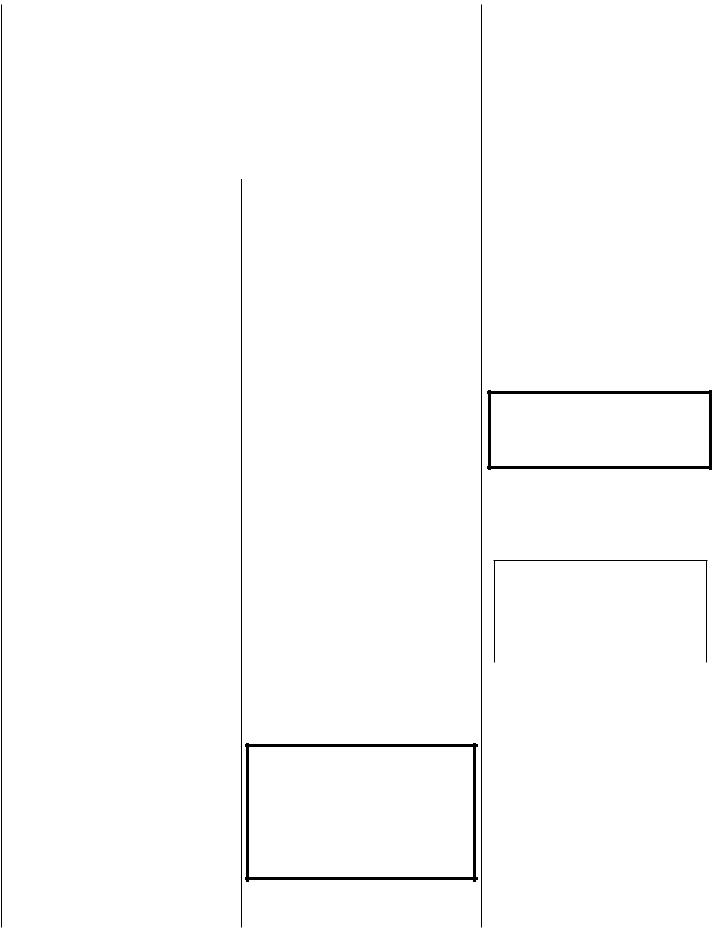
CONGRATULATIONS!
In selecting this LENNOX B-Vented Gas Appliance you have chosen the finest and most dependable fireplace to be found anywhere. Its a beautiful, prestigious alternative to a wood burning fireplace. Welcome to a Family of tens of thousands of satisfied LENNOX Fireplace Owners.
Please carefully read and follow all of the instructions found in this manual. Please pay special attention to the safety instructions provided in this manual. The Homeowner's Care and Operation Instructions included here will assure that you have many years of dependable and enjoyable service from your LENNOX product.
TABLE OF CONTENTS |
|
|
Introduction ...................................... |
page |
2 |
General Information .......................... |
page |
2 |
Operation/Care of Your Appliance ..... |
page |
3 |
Gas Controls/Control Compartment, |
|
|
Access ............................................ |
page |
4 |
Variable Flame Adjustment ............... |
page |
5 |
Outside Combustion Air Control ....... |
page |
5 |
Venting Action and Safety Limit ........ |
page |
5 |
Maintenance ..................................... |
page |
6 |
Front Glass Enclosure Panel, |
|
|
Removal and Installation ................ |
page |
6 |
Maintenance Schedule ...................... |
page |
7 |
Burner Adjustments .......................... |
page |
8 |
Log Placement .................................. |
page |
9 |
Vermiculite and Black/Gray Ceramic |
|
|
Fiber Chunks Placement ................ |
page |
9 |
Millivolt Appliance Checkout ............. |
page |
9 |
Electronic Appliance Checkout .......... |
page 10 |
|
Wiring Diagrams ............................... |
page 10 |
|
Warranty ........................................... |
page 10 |
|
Replacement Parts ............................ |
page 10 |
|
Product Reference Information ........ |
page 10 |
|
Accessory Components .................... |
page 11 |
|
Lighting Instructions – Millivolt ........ |
page 14 |
|
Lighting Instructions – Electronic ..... |
page 16 |
|
Troubleshooting Guide – Millivolt ...... |
page 18 |
|
Troubleshooting Guide – Electronic ... |
page 19 |
|
Replacement Parts List ...................... |
page 21 |
|
INTRODUCTION
The millivolt appliances are designed to operate on either natural or propane gas. A millivolt gas control valve with piezo ignition system provides safe, efficient operation. If any optional accessories which require electrical power are being installed, the electrical power must be provided at the time of appliance installation.
The electronic appliances are designed to operate on either natural or propane gas. An electronic intermittent pilot system provides safe, efficient operation. External electrical power is required to operate these units.
These appliances comply with National Safety Standards and are tested and listed by OmniTest Laboratories (Report No. 116-F-07-5) to ANSI Z21.50 - 2000 (in Canada, CSA 2.22 - 2000), and CAN/CGA-2.17-M91 in both USA and Canada, as vented gas fireplaces.
Installation must conform to local codes. In the absence of local codes, installation must comply with the current National Fuel Gas Code, ANSI Z223.1 (NFPA 54). (In Canada, the current CAN/CGA B149 installation code.) Electrical wiring must comply with local codes. In the absence of local codes, installation must be in accordance with the National Electrical Code, NFPA 70 - (latest edition). (In Canada, the current CSA C22.1 Canadian Electric Code.)
DO NOT ATTEMPT TO ALTER OR MODIFY THE CONSTRUCTION OF THE APPLIANCE OR ITS COMPONENTS. ANY MODIFICATION OR ALTERATION MAY VOID THE WARRANTY, CERTIFICATION AND LISTINGS OF THIS UNIT.
WARNING: IMPROPER INSTALLATION, ADJUSTMENT, ALTERATION, SERVICE OR MAINTENANCE CAN CAUSE INJURY OR PROPERTY DAMAGE. REFER TO THIS MANUAL. FOR ASSISTANCE OR ADDITIONAL INFORMATION CONSULT A QUALIFIED INSTALLER, SERVICE AGENCY OR THE GAS SUPPLIER.
2 |
NOTE: DIAGRAMS & ILLUSTRATIONS NOT TO SCALE. |
GENERAL INFORMATION
Note: Installation and repair should be performed by a qualified service person. The appliance should be inspected annually by a qualified professional service technician. More frequent inspections and cleanings may be required due to excessive lint from carpeting, bedding material, etc. It is imperative that the control compartment, burners and circulating air passage ways of the appliance be kept clean.
S'assurer que le brùleur et le compartiment des commandes sont propres. Voir les instructions d'installation et d'utilisation qui accompagnent l'appareil.
Provide adequate clearances around air openings and adequate accessibility clearance for service and proper operation. Never obstruct the front openings of the appliance.
Due to high temperatures the appliance should be located out of traffic and away from furniture and draperies. Locate furniture and window coverings accordingly.
WARNING: THESE FIREPLACES ARE VENTED DECORATIVE GAS APPLIANCES. DO NOT BURN WOOD OR OTHER MATERIAL IN THESE APPLIANCES.
These appliances are designed to operate on natural or propane gas only.
Input of millivolt models is shown in the following table:
Millivolt Models
Natural and Propane |
Input rate (BTU/H) |
|
Gas Models |
Manually-modulated |
|
EBSTNM-2, EBPFNM-2, |
|
|
EBSTPM-2, EBPFPM-2, |
30,000 TO 37,500 |
|
EBBAYNM, EBBAYNP |
|
|
EBCLNM-2, EBCRNM-2, |
26,000 TO 34,000 |
|
EBCLPM-2, EBCRPM-2 |
||
|
Input of electronic models is shown in the following table:
Electronic |
Models |
|
Natural and Propane |
Input rate (BTU/H) |
|
Gas Models |
Fixed Rate |
|
EBSTNE-2, EBPFNE-2, |
|
|
EBSTPE-2, EBPFPE-2, |
37,500 |
|
EBBAYNE |
|
|
EBCLNE-2, EBCRNE-2, |
34,000 |
|
EBCLPE-2, EBCRPE-2 |
||
|
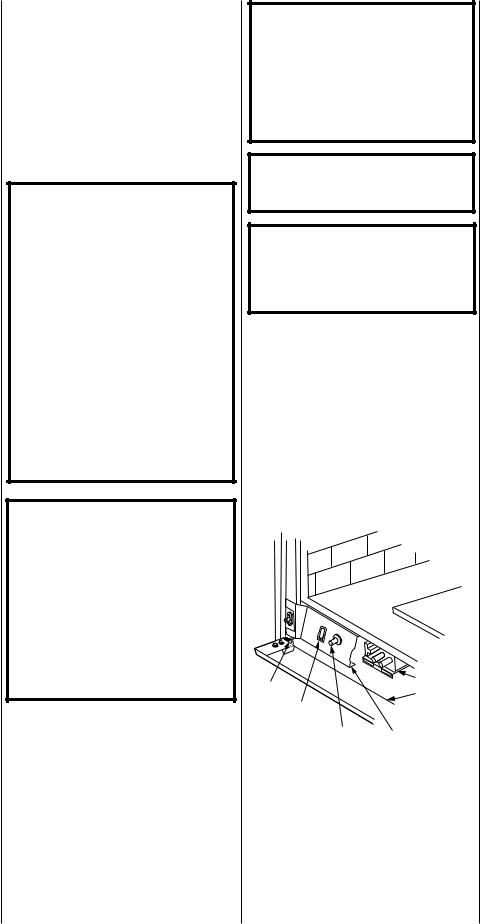
The following table shows the units' gas orifice size for the elevations indicated:
Model |
Orifice size* |
Elevation |
||
No. |
|
|
Feet (meters) |
|
Nat. |
Prop. |
|||
|
|
|||
|
|
|
|
|
EBST-2 |
|
|
|
|
EBPF-2 |
#44 |
#55 |
0-4500 |
|
EBBAY |
|
|
||
|
|
(0-1372) |
||
EBCR-2 |
#47 |
0.05" |
||
|
||||
EBCL-2 |
|
|||
|
|
|
||
|
|
|
|
|
* Each model has two burners. Each burner contains one of these orifices.
Maximum manifold pressure is 3.5 in. w.c. (0.87 kPa) for natural gas and 10 in. w.c. (2.49 kPa) for LP/Propane gas.
Do not use these appliances if any part has been under water. Immediately call a qualified, professional service technician to inspect the appliance and to replace any parts of the control system and any gas control which have been under water.
Ne pas se servir de cet appareil s'il a été plongé dans l'eau, complètement ou en partie. Appeler un technicien qualifié pour inspecter l'appareil et remplacer toute partie du système de contrôle et toute commande qui ont été plongés dans l'leau.
Test gage connections are provided on the front of the millivolt gas control valve (identified OUT for the manifold side and IN for inlet pressure. A ¹⁄ " NPT test gage connection is provided on the electronic gas control valve adjacent to the outlet to the main burner.
Minimum inlet gas pressure to these appliances is 5.0 inches water column (1.24 kPa) for natural gas and 11 inches water column (2.74 kPa) for propane for the purpose of input adjustment.
Maximum inlet gas supply pressure to these appliances is 10.5 inches water column (2.61 kPa) for natural gas and 13.0 inches water column (3.23 kPa) for propane.
The appliance must be isolated from the gas supply piping system (by closing its individual manual shut-off valve) during any pressure testing of the gas supply piping system at test pressures equal to or less than ¹⁄ psig (3.5 kPa).
The appliance and its individual shut-off valve must be disconnected from the gas supply piping system during any pressure testing of that system at pressures in excess of ¹⁄ psig (3.5 kPa).
These appliances must not be connected to a chimney or flue serving a separate solid fuel burning appliance.
Any safety guard or screen removed for servicing the appliance must be replaced prior to operating the appliance.
WARNING: B-VENTAPPLIANCESARENOT DESIGNED TO OPERATE IN NEGATIVELY PRESSUREDENVIRONMENTS(PRESSURE WITHIN THE HOME IS LESS THAN PRESSURES OUTSIDE). SIGNIFICANT NEGATIVELY PRESSURED ENVIRONMENTS CAUSED BY WEATHER, HOME DESIGN, OR OTHER DEVICES MAY IMPACT THE OPERATION OF THESE APPLIANCES. NEGATIVE PRESSURES MAY RESULT IN POOR FLAME APPEARANCE, SOOTING, DAMAGE TO PROPERTY AND/OR SEVERE PERSONAL INJURY. DO NOT OPERATE THESEAPPLIANCESINNEGATIVELYPRESSURED ENVIRONMENTS. PROVIDING ADEQUATE VENTILATION TO THE APPIANCE FOR COMBUSTION AIR WILL ELIMINATE A NEGATIVE PRESSURE ENVIRONMENT.
WARNING: FAILURE TO COMPLY WITH THE INSTALLATION AND OPERATING INSTRUCTIONS PROVIDED IN THIS DOCUMENT WILL RESULT IN AN IMPROPERLY INSTALLED AND OPERATING APPLIANCE, VOIDING ITS WARRANTY. ANY CHANGE TO THIS APPLIANCE AND/OR ITS OPERATING CONTROLS IS DANGEROUS. IMPROPER INSTALLATION OR USE OF THIS APPLIANCE CAN CAUSE SERIOUS INJURY OR DEATH FROM FIRE, BURNS, EXPLOSION OR CARBON MONOXIDE POISONING.
Carbon Monoxide Poisoning: Early signs of carbon monoxide poisoning are similar to the flu with headaches, dizziness and/or nausea. If you have these signs, obtain fresh air immediately. Turn off the gas supply to the appliance and have it serviced by a qualified professional, as it may not be operating correctly.
NOTE: DIAGRAMS & ILLUSTRATIONS NOT TO SCALE.
WARNING: CHILDREN AND ADULTS SHOULD BE ALERTED TO THE HAZARDS OF HIGH SURFACE TEMPERATURES. USE CAUTION AROUND THE APPLIANCE TO AVOID BURNS OR CLOTHING IGNITION. YOUNG CHILDREN SHOULD BE CAREFULLY SUPERVISED WHEN THEY ARE IN THE SAME ROOM AS THE APPLIANCE.
WARNING: DO NOT PLACE CLOTHING OR OTHER FLAMMABLE MATERIALS ON OR NEAR THIS APPLIANCE.
AVERTISSEMENT: SURVEILLER LES ENFANTS. GARDER LES VÊTEMENTS, LES MEUBLES, L'ESSENCE OU AUTRES LIQUIDES À VAPEUR INFLAMMABLES LOIN DE L'APPAREIL.
OPERATION AND CARE OF YOUR
APPLIANCE
Appliance operation may be controlled by the following means: the factory provided modesty panel-mounted ON-OFF control switch, an optional wall-mounted ON-OFF switch or optional remote control.
The modesty panel mounted ON-OFF control switch is located behind the control compartment access panel, below the appliance front glass enclosure panel. See Figure 1.
Hinge |
|
Gas Valve |
|
|
Control |
||
Pin |
|
||
ON/OFF |
Compartment |
||
|
|||
|
Access panel |
||
|
Switch |
||
|
|
Piezo Ignitor Modesty Panel
Control Compartment Access -
Millivolt Control Valve Shown
Figure 1
3
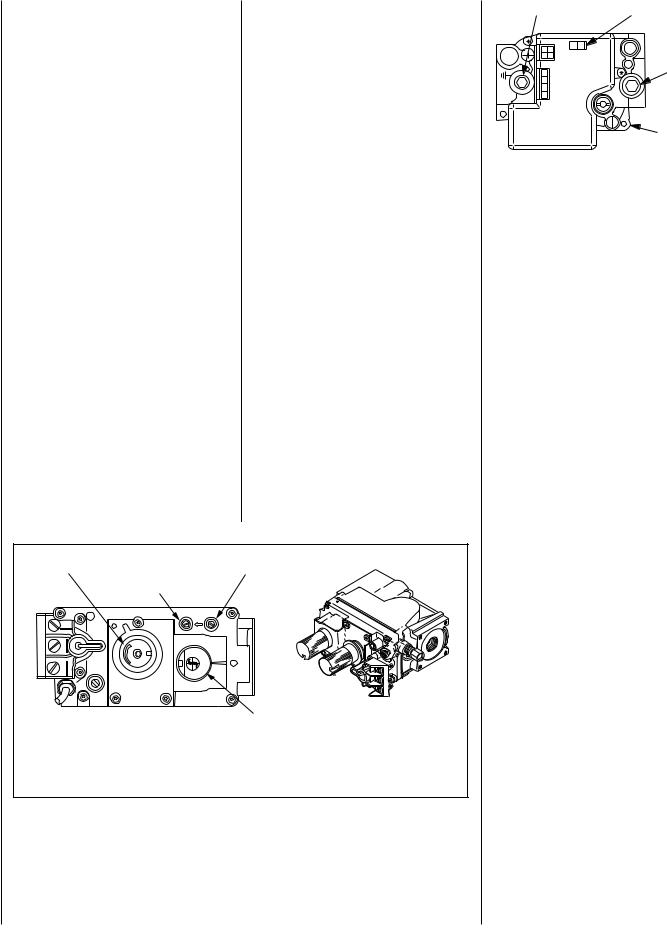
GasControls/ControlCompartmentAccess
The gas controls can be found behind the control compartment access panel.
To open the control compartment access panel, actuate the spring-loaded magnetic catches securing the panel, by gently depressing the outer top corners of the panel until the catches "pop" the door free, allowing it to swing out and down to open.
On millivolt systems, the piezo ignitor, Hi/Lo flame adjustment knob, and pilot and main gas ON/OFF control knob are located on the modesty panel. On both millivolt and electronic systems the gas valve is located behind the modesty panel. Refer to Figure 1.
Remove the bottom control compartment access panel by compressing the spring-loaded hinge pin on the left side until it disengages from the left cabinet panel hole. Pull the panel away from the fireplace.
Once the control compartment access panel has been removed, the modesty panel can be removed as follows: pull the bottom right corner of the modesty panel out slightly to disengage the snap-fit feature; lift the modesty panel by the tab on the panel's right end, pull the right end of the panel away from the cabinet and then pull the panel diagonally out of the left side cabinet panel slots. (In the above procedure, reverse the words "left" and "right" for EDCR-2 models).
Remove the modesty panel carefully, so that none of the wires become loose or disconnected. Now complete access to the gas control valve and its related controls is attainable.
To ease door closure, depress the catches to place them in their retracted position, then close the door.
Operation of millivolt and electronic gas control systems are different. Before lighting and operating your appliance determine if you have a millivolt or electronic appliance. Refer to Figure 1 on page 4 for access to the gas control valve. Millivolt appliances will be fitted with the gas control valve shown in Figure 2.
Appliances with electronic systems will be fitted with the electronic valve shown in Figure 3. Familiarize yourself with the gas control valve that your appliance uses.
Millivolt Appliances -
To light millivolt appliances refer to the detailed lighting instructions found on page 13 (English) and page 14 (French). Millivolt appliance lighting instructions may also be found on the pull out lighting instruction labels attached to the gas control valve.
Millivolt appliances are fitted with a burner ON/ OFF control switch (rocker switch). See Figure 1 on page 3 for its location. Once the pilot is lit, the ON/OFF rocker switch will control the appliance ON/OFF operation. To operate: Toggle the switch between its ON and OFF positions.
Variable Flame Height Adjustment |
Inlet Pressure Port |
||||
|
Manifold Pressure Port |
|
|||
|
|
|
OUT |
IN |
|
TPTH |
|
|
|
|
|
TP |
|
I H |
|
|
|
|
|
|
OFF |
P |
|
|
|
|
|
|
|
|
|
|
|
I |
|
|
|
LO W |
it |
L |
|
TH |
|
O |
|
||
|
|
|
NO |
T |
|
|
|
|
|
|
|
|
|
P |
|
|
|
|
I |
|
|
|
|
|
TOL |
|
|
|
|
|
|
|
|
|
Main Gas |
|
SIT Millivolt Gas Valve |
Control Knob |
|||
Note: The piezo ignitor is located on the modesty panel - see Figure 1.
Figure 2
4 |
NOTE: DIAGRAMS & ILLUSTRATIONS NOT TO SCALE. |
Manifold Pressure Port |
ON/OFF Switch |
||
CONTROL |
OFF ON |
IN |
Inlet |
RITENIG |
|
|
Pressure |
|
|
Port |
|
|
|
|
|
|
|
PSI |
|
|
|
|
Electronic |
|
|
|
Gas Control |
|
|
|
Valve |
|
|
Honeywell Electronic |
|
Figure 3 |
|
|
Gas Valve |
If your millivolt appliance is equipped with an optional wall-mounted ON/OFF switch or remote control kit and the pilot is lit, the appliance main burner may be turned on and off with the wall switch or remote control.
Electronic Appliances -
To light electronic appliances refer to the detailed lighting instructions found in both English and French on pages 15 and 16 of these instructions respectively. Electronic appliance lighting instructions may also be found on the pull out lighting instruction labels attached to the gas control valve.
Electronic appliances are fitted with a ON/OFF burner control switch (rocker switch). See Figure 1 on page 3 for its location. The electronic system will go through the whole lighting sequence automatically once the rocker switch is toggled to the ON position.
If your electronic appliance is equipped with an optional wall-mounted ON/OFF switch or remote control kit the appliance main burner may be turned on and off with the wall switch or remote control.
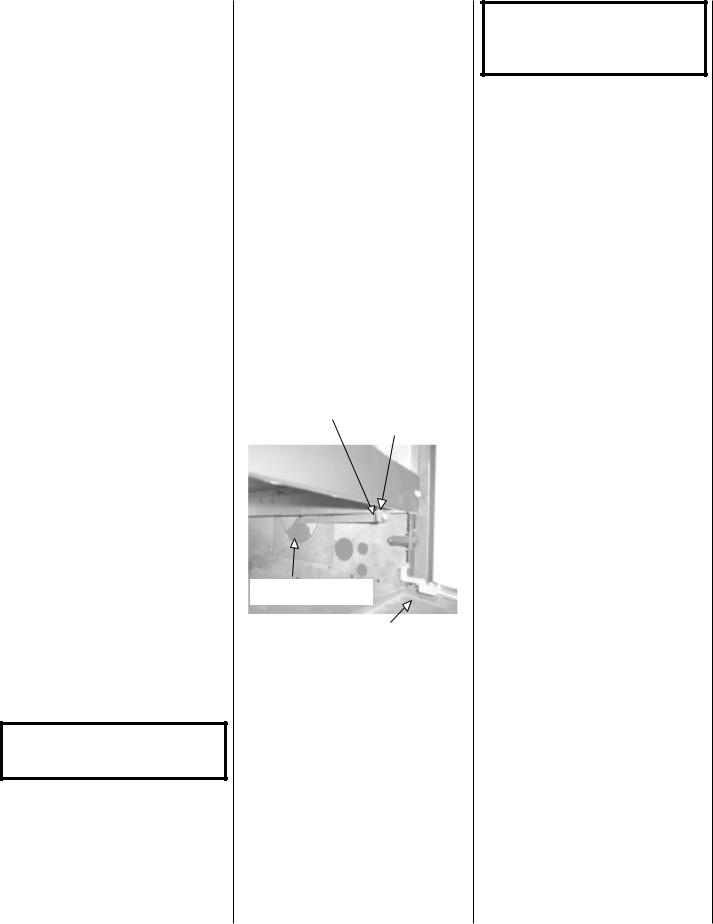
Variable Flame Height Adjustment ( Millivolt Appliances only)
1. All Millivolt appliances are equipped with a variable gas control valve. Flame height for these models may be adjusted through a range between fixed low and high settings while the appliance is in operation.
Adjust the flame height as desired after lighting the appliance by rotating the variable adjustment control knob located on the front of the valve (refer to Figure 2). (An extension is provided to this knob so that the adjustment may be made at the modesty panel.)
2.When lit for the first time, this appliance will emit a slight odor for 14 hours. This is due to the “burn-in” of internal paints and lubricants used in the manufacturing process.
3.Keep lower control compartment clean by vacuuming or brushing at least twice a year. More frequent cleaning may be required due to excessive lint from carpeting, bedding materials, etc. It is important that control compartments, burners and circulating air passageways of the appliance be kept clean.
4.Always turn off gas to the pilot (millivolt appliances) and let the unit cool down before cleaning. Before re-lighting, refer to the lighting instructions in this manual. Lighting instructions may also be found on the pull out lighting instruction labels attached to the gas control valve.
5.Always keep the appliance area clear and free from combustible materials, gasoline and other flammable liquids.
6.Remember, Millivolt appliances have a continuous burning pilot flame. Exercise caution when using products with combustible vapors.
7.Clean the front glass enclosure only when necessary and when the unit is cool. Wipe surface with clean, dampened, soft cloth. Follow with dry, soft towel as desired. Take care not to scratch the glass surface.
WARNING: DO NOT USE ABRASIVE CLEANERS. NEVER CLEAN THE GLASS WHEN IT IS HOT.
CAUTION: DO NOT TOUCH THE FRONT ENCLOSURE GLASS WITH YOUR HANDS WHILE THE FIREPLACE IS IN USE.
Outside Combustion Air Controls
Many appliances are equipped, when installed, with an outside (make-up air) vent system that is designed to provide the appliance with outside make-up air for combustion when in operation. The outside air control lever for the outside air system is standard on all appliances but should not be operated if the complete system is not installed. Refer to Figure 4. When the complete outside air vent system is installed, the installer will remove the securing screw from the combustion air control lever located on the right side (EBST- 2, EBPF-2 and EBCL-2), or left side (EBCR-2) of the fireplace opening.
If the securing screw has not been removed and you have reason to believe that you have a complete outside air system, contact your distributor to have your appliance inspected for the presence of the complete system. DO NOT assume that you have this system in place.
Outside Air Control Lever with Stop Behind Securing Screw
Outside Air Shutter in the
Closed Position
Control Compartment Access Panel
Outside Air Control Lever
and Securing Screw Location
(EBST-2, EBPF-2 and EBCR-2 Units Shown)
Figure 4
NOTE: DIAGRAMS & ILLUSTRATIONS NOT TO SCALE.
WARNING:DONOTOPERATETHESHUTOFF LEVER UNLESS A COMPLETE OUTSIDE COMBUSTION AIR SYSTEM HAS BEEN INSTALLED WITH YOUR APPLIANCE.
To open the outside air shutter, open the botttom control access panel, reach into the gap between the firebox bottom and the modesty panel, and pull the outside air control lever all the way out. The outside air shutter should be fully open when the fireplace is in use and completely closed when the fireplace is not being used. Closing it when not in use will prevent outside cold air from entering the dwelling.
Venting Action and Safety Limit Operation
If you suspect that the appliance is not venting properly, or you notice windows fogging or sweating, you may want to conduct the following spillage test:
1 - Place unit in its normally-operated condition, that is, with the glass enclosure panels in place.
2 - Close all doors and windows in the room. Turn on all exhaust fans in the house. 3 - Light the appliance.
4 - Wait 15 minutes.
5 - To check for venting action, start by holding a smoke producing device within an inch of one edge (side edge, not top or bottom edge) of one glass enclosure panel. The smoke should be drawn toward the edge of the glass enclosure panel. Continue the test by moving the smoke producing device along the entire length of both side-edges of the glass door. Repeat the test for all glass enclosure panels.
6 - If the smoke is not drawn towards the edges of the glass door turn off the appliance and call a qualified service technican.
5
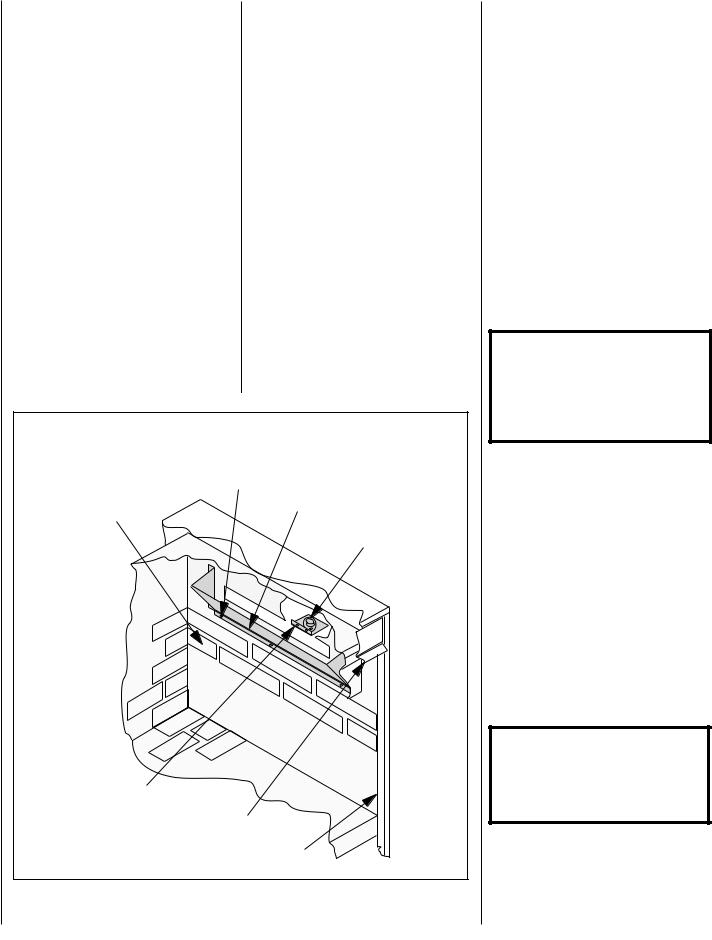
Manual-Reset Safety Limit Switch
This appliance is equipped with a manualreset blocked flue safety limit switch. Refer to Figure 5 for its location. If, during appliance operation, the flame goes out (independently of the burner on/off wall switch), it may be due to the operation of this safety limit switch.
First allow the appliance to cool, then reset the safety switch by pushing the red reset button on it.
A - To access the blocked flue safety switch when top radiant panel is not covered with non-combustible material:
1 - Lift up and remove top radiant panel/ eyebrow assembly on the control side of unit.
2 - Reach between the cabinet side and the firebox side wall and locate the blocked flue safety switch.
3 - Push the red reset button on the switch.
The applilance should then relight and remain lit. If this does not occur, turn off the appliance and call a qualified service technician.
B - To access the blocked flue safety switch when top radiant panel is covered with noncombustible material:
Note: This procedure should only be performed by a qualified service technician.
1 - Lower bottom hinged panel on the control side of the fireplace. Remove the modesty panel and glass enclosure panel as described on page 8, under "Remove the front glass enclosure panel as follows:", Steps 2, 3, 4, 5 and 6.
2 - Remove the side baffle securing screws
(5) and then remove the baffle.
3 - Remove the safety switch bracket securing screws (2), and pull the switch/bracket assembly through the side panel slot.
4 - Push the red reset button on the switch. 5 - Reinstall the switch/bracket assembly. 6 - Reinstall the side baffle.
7 - Reinstall front glass door.
8 - Raise the bottom hinged panel.
The appliance should then relight and remain lit. If this does not occur, check unit for a blocked flue condition.
SAFETY SWITCH LOCATION (EBCL-2 SHOWN)
EBST-2 and EBPF-2 Safety Switch Location Also as Shown; EBCR-2 Location on Left End of Fireplace, EBBAY Location on The Rear of Fireplace.
|
FIREBOX SIDE BAFFLE SECURING SCREW |
FIREBOX BOX |
FIREBOX SIDE BAFFLE |
SIDE WALL |
|
|
MANUALLY-RESET |
|
SAFETY LIMIT SWITCH |
SAFETY SWITCH
BRACKET SECURING SCREW
TOP RADIANT PANEL
AND EYEBROW
CABINET SIDE WALL
Figure 5
6 |
NOTE: DIAGRAMS & ILLUSTRATIONS NOT TO SCALE. |
Maintenance
The appliance and venting system should be thoroughly inspected before initial use and at least annually by a qualified service technician. However, more frequent periodic inspections and cleanings should be performed by the homeowner. Homeowner must contact a qualified service technician at once if any abnormal condition is observed.
Refer to the maintenance schedule for maintenance tasks, procedures, periodicity and by whom they should be performed. Always verify proper operation of the appliance after servicing.
IMPORTANT: TURN OFF GAS AND ANY ELECTRICAL POWER BEFORE SERVICING THE APPLIANCE.
Front Glass Enclosure Panel, Removal
and Installation.
WARNING: NEVER OPERATE THE APPLIANCE WITHOUT THE GLASS ENCLOSURE PANELS IN PLACE AND SECURE. DO NOT OPERATE APPLIANCE WITH FRONT GLASS CRACKED, BROKEN OR MISSING. REPLACEMENT MUST BE DONE BY A LICENSED OR QUALIFIED SERVICE TECHNICIAN.
These fireplaces are designed to operate only with the glass enclosure panels properly installed. Generally the glass enclosure panels should not be removed except to gain access to the components within the firebox, and the appliance may only be operated without the front glass enclosure panel in place for very brief periods of time during initial appliance checkout and adjustment.
During this appliance checkout and adjustment period, a potential safety hazard exists - EXERCISE EXTREME CAUTION to prevent the occurrence of any burn injuries from the exposed flames or hot surfaces. Also note, that while the front glass enclosure panel (or any of the panels) is removed, the flame appearance will appear to be smaller than normal.
WARNING: HANDLE THE GLASS WITH EXTREME CARE! TEMPERED GLASS IS SUSCEPTIBLE TO DAMAGE (SCRATCHES, FOR EXAMPLE) – HANDLE GLASS DOOR (GLASS ENCLOSURE PANEL) GENTLY WHILE REINSTALLING IT.

Maintenance Schedule
Annually (Before the onset of the Burning Season)
|
Maintenance Task |
Accomplishing Person |
Procedure |
|
|
|
|
|
Inspecting/Cleaning Burner, Logs |
Qualified Service Technician |
Inspect valve and ensure it is properly operat- |
|
and Controls |
|
ing. Check piping for leaks. Vacuum the con- |
|
|
|
trol compartment, fireplace logs and burner |
|
|
|
area. |
|
|
|
|
|
Check Flame Patterns and Flame Height |
Qualified Service Technician |
Refer to Figure 8 on page 8 and verify that the |
|
|
|
flame pattern and height displayed by the |
|
|
|
appliance conforms to the picture. Flames |
|
|
|
must not impinge on the log set. |
|
|
|
|
|
Inspecting/Cleaning Pilot Burner and the Two |
Qualified Service Technician |
Refer to Figure 1 on page 8 (SIT) or Figure 12 |
|
Main Burners |
|
on page 9 (Honeywell). Remove any surface |
|
|
|
build-up on pilot and burner assembly. Clean the |
|
|
|
pilot nozzles, ignitor/flame rod and hood with a |
|
|
|
soft brush. Ensure the pilot flame engulfs the |
|
|
|
flame sensor as shown. |
|
|
|
|
|
Checking Vent System |
Qualified Service Technician |
Inspect the vent system at the top and at the |
|
|
|
base (within the firebox) for signs of blockage |
|
|
|
or obstruction. Look for any signs of disloca- |
|
|
|
tion of the vent components. |
|
|
|
|
|
Appliance Checkout |
Qualified Service Technician |
Perform the appropriate appliance checkout |
|
|
|
procedure detailed in this manual. |
Periodically (After the Burning Season) |
|
|
|
|
|
|
|
|
Maintenance Task |
Accomplishing Person |
Procedure |
|
|
|
|
|
Cleaning Firebox Interior |
Homeowner |
Carefully remove logs, vermiculite and black and |
|
|
|
gray ceramic fiber chunks. Vacuum out interior of |
|
|
|
the firebox. Clean firebox walls and log grate. |
|
|
|
Replace logs, vermiculite and black and gray ce- |
|
|
|
ramic fiber chunks as detailed on page 8. |
|
|
|
|
|
Check Flame Patterns and Flame Height |
Homeowner |
Refer to Figure 8 on page 8 and verify that |
|
|
|
the flame pattern and height displayed by the |
|
|
|
appliance conforms to the picture. Flames |
|
|
|
must not impinge on the log set. |
|
|
|
|
|
Checking Vent System |
Homeowner |
Inspect the vent system at the top and at the |
|
|
|
base (within the firebox) for signs of block- |
|
|
|
age or obstruction. Look for any signs of |
|
|
|
dislocation of the vent components. |
|
|
|
|
|
Cleaning Glass Enclosure Panels |
Homeowner |
Clean as necessary following the directions |
|
|
|
provided in this manual. DO NOT TOUCH OR |
|
|
|
CLEAN GLASS WHILE IT IS HOT. |
|
|
|
|
NOTE: DIAGRAMS & ILLUSTRATIONS NOT TO SCALE. |
7 |
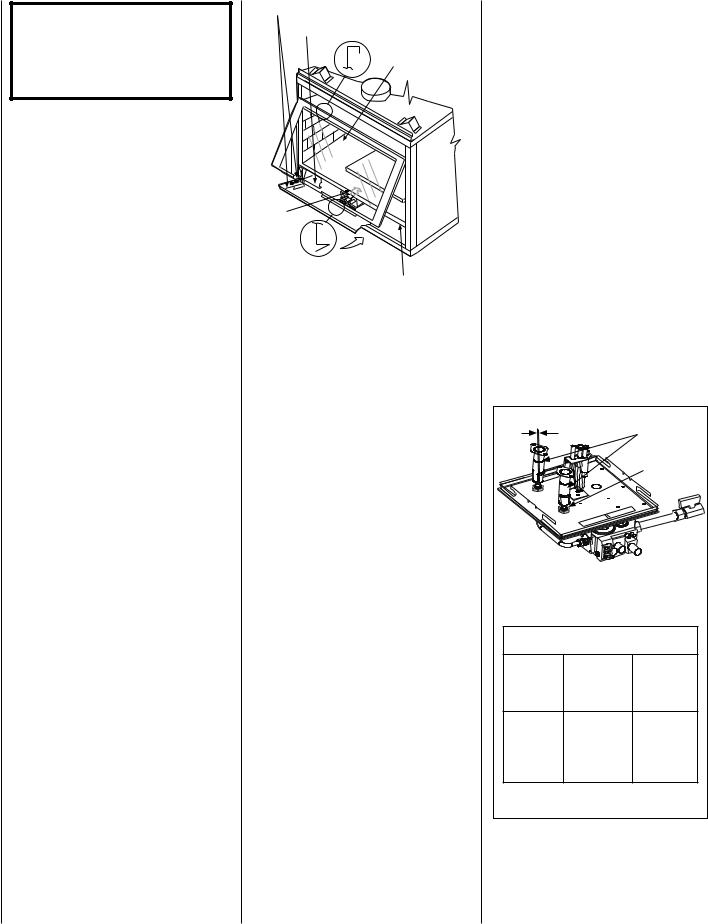
WARNING: DO NOT ATTEMPT TO SUBSTITUTE THE MATERIALS USED ON THESE DOORS, OR REPLACE CRACKED OR BROKEN GLASS WITH ANY MATERIALS OTHER THAN THOSE PROVIDED BY THE APPLIANCE MANUFACTURER.
THE GLASS DOORS OF THIS APPLIANCE MUST ONLY BE REPLACED AS A COMPLETE UNIT AS PROVIDED BY THE MANUFACTURER. DO NOT ATTEMPT TO REPLACE BROKEN, CRACKED OR CHIPPED GLASS SEPARATELY.
Refer to Figure 6 and remove the front glass enclosure panel as follows:
1.Remove the top bustle, and the top louver assembly or radiant panel. Then remove the bottom bustle.
2.Open the control compartment access panel. To open the control compartment access panel, actuate the spring-loaded magnetic catches securing the panel, by gently depressing the outer top corners of the panel until the catches "pop" the door free, allowing it to swing out and down to open.
3.Remove the bottom control compartment access panel by compressing the spring-loaded hinge pin on the left side until it disengages from the left cabinet corner post hole. Pull the panel away from the fireplace.
4.Once the control compartment access panel has been removed, the modesty panel can be removed as follows: pull the bottom right corner of the modesty panel out slightly to disengage the snap-fit feature; lift the modesty panel by the tab on the panel's right end, pull the right end of the panel away from the cabinet and then pull the panel diagonally out of the left side cabinet panel slots. (In the above procedure, reverse the words "left" and "right" for EBCR-2 models).
Remove the modesty panel carefully, so that none of the wires become loose or disconnected. Now complete access to the gas control valve and its related controls is attainable.
8
Lower Compartment Door and Hinge
Modesty Panel |
Top Flange |
|
(Glass Enclosure |
||
|
||
|
Panel Frame) |
|
|
Front Glass |
|
|
Enclosure Panel |
Glass
Enclosure
Panel
Latch
Bottom Vee-flange |
|
(Glass Enclosure |
Firebox Floor |
Panel Frame) |
|
EBST-2 SHOWN |
|
Figure 6 |
|
5.Locate the latch at the top of the control compartment. To disengage the latch from the bottom vee-flange of the glass enclosure panel, reach for the handle located towards the back of the latch and pull the handle down towards the front of the unit.
6.Swing the bottom of the door out and raise it slightly to lift the top flange of the door frame away from the appliance.
To install the front glass enclosure panel, proceed as follows:
1.Visually inspect the gasket on the backside of the panel. The gasket surface must be clean, free of irregularities and seated firmly.
2.Position the glass enclosure panel in front of the firebox opening at a 45 degree angle and engage the top flange over the lip at the top of the firebox opening.
3.Swing the glass enclosure panel down and back. Ensure the gasket seats evenly as the panel draws shut. Engage the Vee-flange at the bottom of the panel with the latch and then close the latch to secure the panel.
NOTE: DIAGRAMS & ILLUSTRATIONS NOT TO SCALE.
4. Reinstall the modesty panel by inserting the tongues on the left side of it into the slots on the left side cabinet panel. Swing the right side of the modesty panel towards the unit. Engage the hook on the right side of the modesty panel with the right side cabinet panel slot. Gently press the bottom right corner of the modesty panel to engage the snap-fit feature.
(The left and right designations used here are reversed in EBCR-2 applications.)
5.Reinstall the bottom control compartment access panel by inserting the right side locating pin into the right side cabinet panel and then the left side spring-loaded pin into the left side cabinet panel.
6.Reinstall the top and bottom bustle, and the top louver assembly or radiant panel.
Burner Adjustments
Note - The air shutter for the burner primary air opening is factory-set. Do not adjust the fac- tory-set position. The factory-set position is shown in Figure 7.
*Air Shutter |
Burner |
Opening |
Venturi |
|
Tube |
|
Orifice |
*Note - Do Not Adjust the Factory-Set Position. Eachofthetwoairshutters(oneforeachburner)are open the amount shown in the table, below.
MAIN BURNER
FACTORY SHUTTER SETTING
Natural Gas
Propane
Models inches
Gas
(mm)
inches (mm)
EBST-2
EBPF-2
EBCR-2 1/16 (1.5) 5/16 (8) EBCL-2
EBBAY
Figure 7
